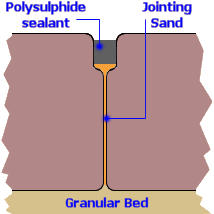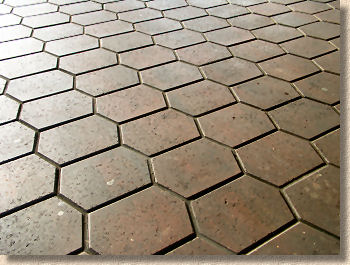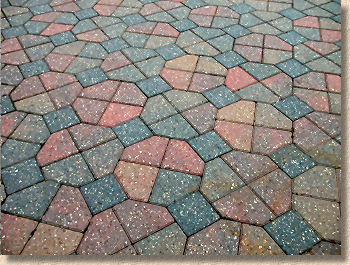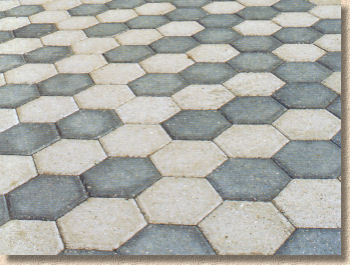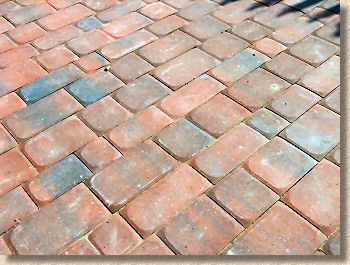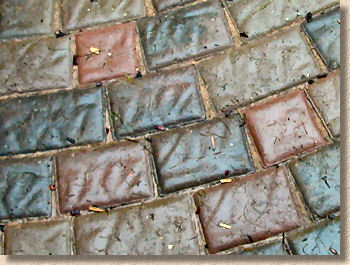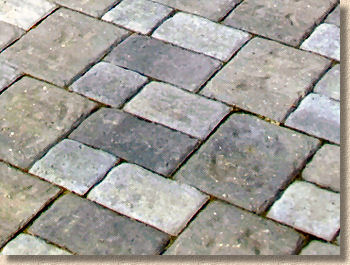Uses and Applications
Back in the 1980s, when Block Paving first really took off in Britain and Ireland, the choice of blocks was relatively simple, amounting to little more than opting for clay bricks (on the left in the photie opposite) or concrete blocks (on the right) and then picking from a handful of colour variations. However, as the market has developed and become more sophisticated, and as manufacturing technology has improved, so the choice of bricks and blocks has, like Alice, grown and grown and grown until we are today faced with over 1,200 different pavers in Britain alone.
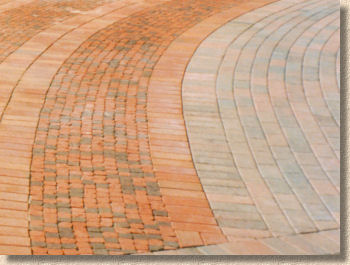
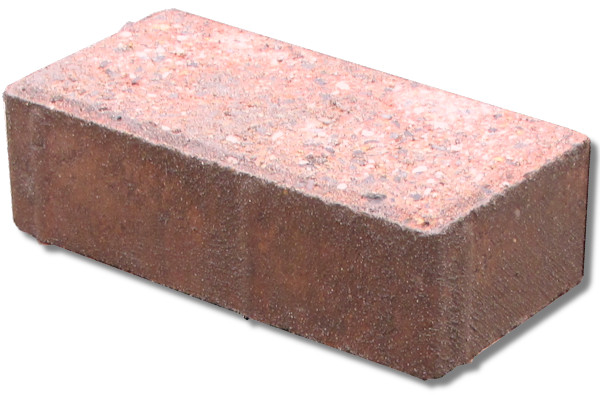
So, how do you choose the right paver for a particular project? This page is intended to guide users, designers, contractors and homeowners through the bewildering array of pavers that are available to them. Certain types of blocks are made by more than one manufacturer - for example, the typical reddy-black rectangular paver that is seen almost everywhere is a British Standard block, or derivative thereof, and is churned out by over half a dozen of the biggest paving manufacturers in the land, often with clever marketing names such as Driveline®, Omega®, Pedesta® and many, many more.
Similarly, if one manufacturer has a new design that seem to be grabbing a slice of the market, it's never very long before the other manufacturers have their own version on sale, often offering a size or colour variation that was not available in the original product.
Concrete or clay?
The first choice to be made is between clay bricks or concrete blocks. The pros and cons of each are listed below...
Concrete
- Relatively cheap
- Plenty of shapes to choose from
- Textured blocks available
- Highly accurate sizes
- Wide choice of block depths, from 40mm to 100mm or more
Clays
- Prices usually slightly higher than concrete, depending on colour
- Extremely hardwearing
- Natural colour will not fade
- Patterned pavers available
- Colours fade over time
- Aggregate can become exposed over time
- Prone to mosses
- Size tolerance is quite variable due to firing process
- Mostly square or rectangular
- Damned hard to cut
- More limited choice of block depths (60, 65 or 80mm)
- Should last at least 20 years
- Will probably outlast all of us, and our children, and probably their children as well!
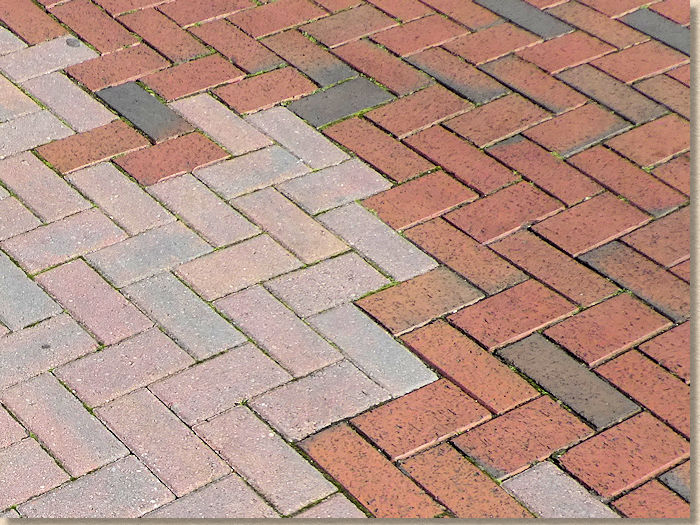
Concrete pavers (on left) were used to 'repair' an area of clay paving (on right). Both types of block are nominally 'red' and both are over 20 years old at the time of the photie.
The colours of the concrete blocks have faded (the manufacturers would say "mellowed") while the clays remain as vibrant as the day they were laid.
A word or two regarding stone block paving
The popularity of imported stone paving has been the outstanding success in the paving industry over the past decade, and what started with stone flags has been consistently developed as stone suppliers looked to expand the advantage handed to them by the shockingly low cost of stone from Asia, Africa, South America and other "Developing Nations", as they are now called. (Has the old "Third World" been abolished in a fit of political correctness?)
One product area that has seen real growth recently is the provision of Natural Stone Block Paving: dimensionally accurate blocks of selected stone that are laid in exactly the same way as the more familiar concrete and/or clay pavers.
A Product Study featuring a leading brand of stone block paving is available on this page .
Further, as manufacturing technology has developed, stone-like concrete pavers have become increasingly available. There is quite a range now available and most of the better products are based on the use of Face Mix production, relying on an upper layer of reconstituted stone , which is often granite or a quartzitic sandstone.
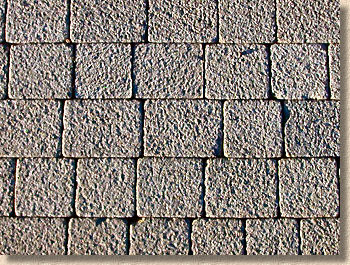
Granite aggregate face
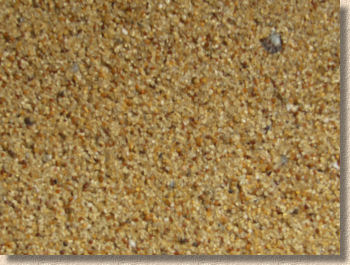
Close-up of superb sandstone aggregate face
Choosing Colour
The most immediately apparent attribute of block or brick paving is colour. There's no definitive guide to choosing the most suitable colour scheme for any given project; it's a decision made after considering the effect of environment and surroundings, the interplay of light and shade, and, most importantly, personal taste. What one person may consider to be a fantastic colour scheme may induce retching and migraine headaches in another.
Consider the immediate surroundings - if you have a buff-toned Cotswold stone cottage, will a red block look right? If it's a car-park surrounded by Accrington Red Stock bricks, would Staffordshire Blue be the best choice?
The key to choosing a successful colour scheme for paving relies on finding a complementary palette, rather than an exact match or a stark contrast.
Consider again the buff-toned Cotswold Cottage – while a pillar-box red is patently not a good choice, a near-identical buff would be a poor choice as the stone and the paving would overwhelm the eye, neither achieving the interest they deserve, the two merging into one amorphous whole. However, if a lighter brown or soft orange or marigold colour scheme was to be used, it would create a differentiation between the paving and the walling, with each component being defined as separate and distinct, but without clashing.
Choose a colour scheme that blends with its environment; buildings, walls, gardens, landscapes, townscapes, rural vistas or urban bustle, all these factors and more combine to create a sensation of appropriateness. The paving should fit in with its environment, because there's little chance of being able to force the environment suit the paving.
Look around the local area. What other colour schemes have been used on pavements? Do they look good or are they awful? Are they sympathetic to the property they serve or do they stand out like the proverbial sore thumb? And don't just look at other block or brick pavements – look at flags or slabs, look at the roads and footpaths, look at walls, windows, look at natural features such as rock outcrops, ponds and lakes, fields and moorlands. The clues are there, in front of you – it's just a matter of training your eye to spot them.
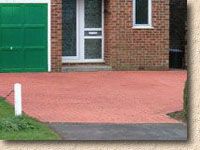
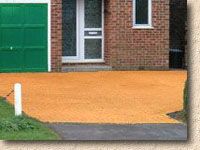
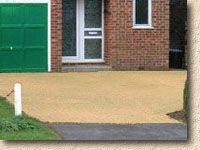
With dark surroundings, a lighter toned pavement may be the contrast that works, but be aware that lighter colours show up stains and tyre marks much more so than darker colours. With light coloured settings, a darker colour choice for the paving may well be ample contrast. And for those who can't decide one way or t'other, there's always grey!
Multicoloured or Monotone?
Basic definitions: a monotone block is a block consisting of a single, uniform colour. It may be red; it may be charcoal; it may have some silly arty-farty name that means nothing to nobody, such as “midnight” – the key factor is that it is one, single, pure colour.

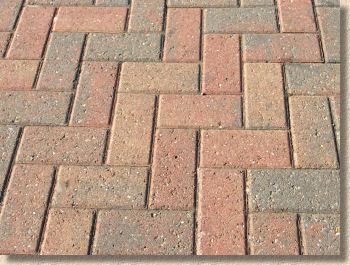
A multicolour is, obviously, a block with more than one colour. It might be a blend of two, three or more colours. There may be varying amounts of each colour within a single block or there may be roughly constant ratios of colours. One thing is fairly certain though: it will probably have some fairly meaningless name dreamt up by a bored office wallah with delusions of grandeur.
Take, for instance, the colour referred to as 'Brindle': what colour springs to mind when you hear "Brindle"? My big crossword-solving dictionary defines Brindle as " having spots or streaks ". One of the witches in Macbeth tells her fellow hags that " thrice the brindled cat hath mewed " (I knew all that Shakespeare would come in useful, one day!) So: how come, in most cases, a brindle paver is a reddy-greyey mish-mash? Yet some manufacturers incorporate buff or light brown into a brindle; some 'brindles' are a dirty red while others have definite red and black splotches of colour. Could a brown and blue paver be described as Brindle?
When choosing a paver for a project, the difference between monotone and multicolours is essential. A multicoloured paver blends better with its surroundings. A monotone is pure and sharp, but shows up even the slightest stain. An all-red pavement will look marvellous until it gets a single oil stain, and then, every time you look at the paving, your eye will zoom in on that one, single, solitary oil-stain, or bird-dropping, or tyre-mark. On a multicoloured pavement, that same stain would be completely lost in the multitude of hues and tones.
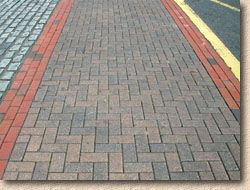
So, why use monotones at all if they are so unforgiving? Well, they give contrast, they give definition, they emphasise patterning, they fulfil a role within a larger colour scheme that may involve the adjacent buildings, or they provide blandness. Some people actually prefer an all-charcoal driveway because, they claim, it looks like tarmacadam - why not have bloody tarmacadam then???
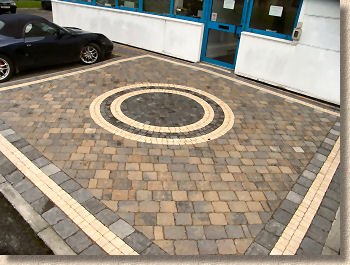

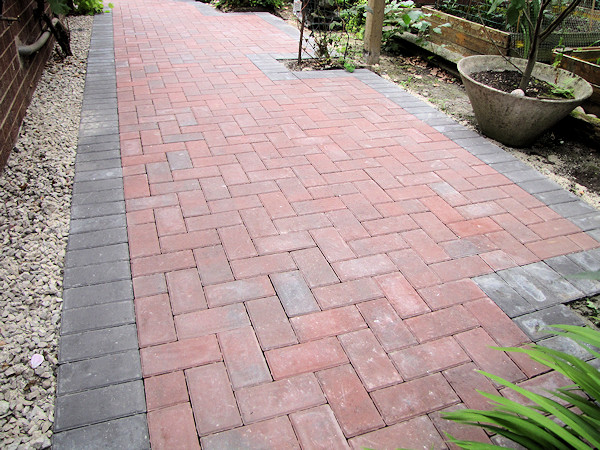
One of the most popular colour schemes chosen for residential block paved driveways blends the best characteristics of both monotones and multicolours. The Brindle and Charcoal Classic – a brindle body with a charcoal soldier edging course. The brindle gives depth and interest and richness while hiding the odd stain or two, and the charcoal provides a frame, a solid definition that boldly states “This is the edge” – the best of both worlds.
Choosing Shape
For some, the idea of a rectangular block isn't exactly inspiring. After all, rectangles have been around since Roman times, or even longer. Surely human ingenuity has come up with something more up-to-date. They want something different, something a bit out of the ordinary, something you don't see on every street.
For historical reasons relating to the manufacturers of block pavers in Britain and Ireland, our nations predominantly use rectangular blocks, but in continental Europe and other more enlightened parts of the world, they use shaped, interlocking or dentate (meaning "toothed") blocks that, because of their shape, have a higher degree of rotational interlock and are better able to withstand heavy traffic that standard rectangular blocks.
Many geometric shapes lend themselves to modular paving, but rectangles are the simplest to manufacture, to package, to palletise and ship to sites and Builders' Merchants throughout the land, and so the British and Irish paving markets have been dominated by rectangles literally since the year dot. While shaped blocks are available at this extreme edge of Europe, they are very much the exception rather than the rule.
W- and S-Blocks
There are dozens of different shaped blocks, but the most common for commercial projects are the W-blocks and the S-blocks.
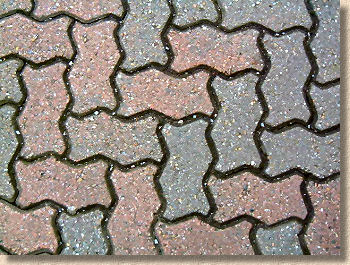
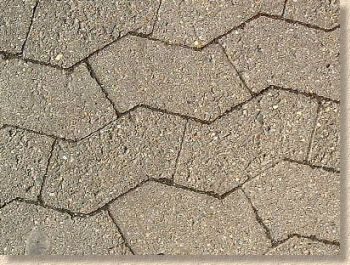
These shaped blocks are used, almost exclusively, on commercial projects and rarely make it as far as patio and driveway work.
However, barely a week goes by without someone emailing or calling to ask about availability. The short answer is that both S- and W- blocks are readily available, as long as you want 600m² or more.
The manufacturers which hold the licence for these blocks have told me that they will only manufacture to order, and that order needs to be at least 600m² or it isn't economic, and, for reasons that defy logic, they claim there are no stocks available for those who just want, say, a couple of packs to repair or extend an existing area.
I know for a fact that there *are* stocks in certain yards: I've seen them! The problem is that the bone-idle sales reps can't be arsed rooting about in the yard to track them down and arrange a small sale.
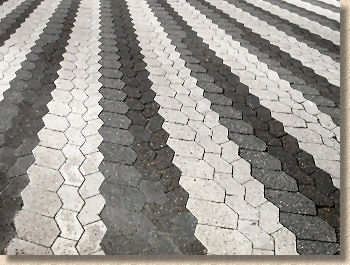
If you are trying to track down these blocks, look for the following brand names:
- Zeta Lock by Brett (W-block)
- Ready-Loc by Cemex (W-block)
- S-Form by ??? - can't find who has UK/Ireland licence
- Randstein (German import)
UniDecor or P-Block
Another popular request is the Uni-Decor block, also known for reasons that escape me, as a P-block....

Uni-Decor's all-too-brief moment in the sun came in the 1990s when it was produced by Marshalls under licence from UniLock in the USA where this is a remarkably resilient and ever-popular choice.
While it had its fans in Britain (never made it as far west as Ireland, apparently) it was relatively pricey compared to 'standard' blocks, and then too many contractors decided to reward themselves for being clever and charged a completely unwarranted premium to install it. The end result was that it was eventually withdrawn and it's become ever more difficult to find old stock or salvaged blocks to effect repairs or extend existing areas.
If I knew who had any stock, or where they could be found, I'd gladly publish and promote the information, but they are, it seems, the proverbial hen's teeth.
As the market for block paving becomes more and more sophisticated, so the demand for new, exciting, innovative products has grown, and the leading manufacturers spend a lot of time, effort and money trying to come up with the fabled 'Next Big Thing'. There is a sense in Britain and Ireland that this NBT will not be a shaped block. It's been tried and tried and tried again and it just never seems to catch on for anything other than heavy duty commercial projects.
This lack of popularity, to be frank, hasn't been helped by silly pricing by manufacturers looking for a bigger-than-normal return on what they see as a 'premium product' and then compounded by greedy contractors wanting to charge more per square metre for laying the blocks, even though they are no more difficult or time-consuming to lay than their rectangular counterparts. Consequently, many of the products illustrated below may not be readily available or may have been withdrawn.
Shaped Blocks Gallery:
We've had hexagons for many years, and there are pentagons, octagons, parallelograms, fans, keyhole-shapes, X-shapes, W-shapes, shapes based on completely baffling mathematical oddities and quite a few shapes that defy definition.
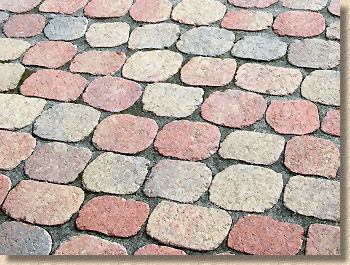
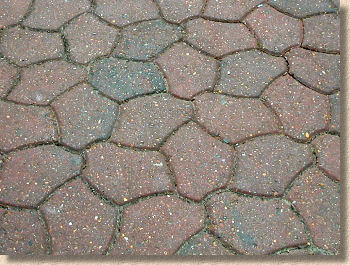
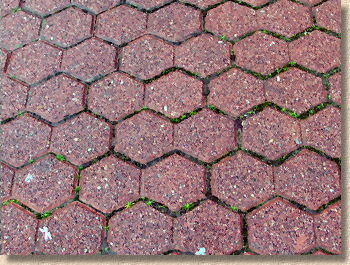
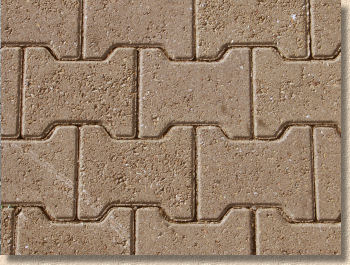
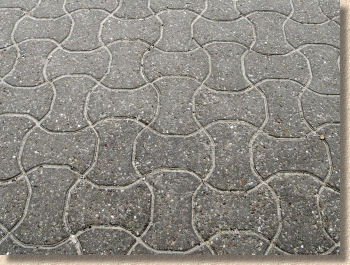
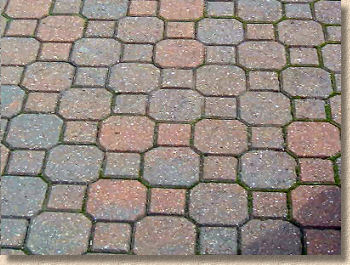

Choosing Style
Consider the immediate surroundings - would a modern, chamfered block paver look right with a 17th century cottage? Would a tumbled antique-style block be the best choice a petrol station forecourt? For a pavement to fit in with its environment, some consideration must be given to the styling.
Blocks and bricks can be sorted into one of the following very loose style categories. They can be:

Shaped - Textured
Standard Blocks
Standard rectangular blocks and bricks are by far the most popular choice in Britain and Ireland. Elsewhere, and particularly in continental Europe, shaped pavers are much more popular, but for some unfathomable reason, the Brits and the Irish have stuck with rectangles and show little interest in anything too racey or daring, such as a S-block.
They may not be exciting, but the one thing that can be said for rectangles is that they are relatively cheap, can be laid in a reasonable range of patterns and work well in most scenarios. The most common block has a length to width ratio of 2:1, but there are a few variations. A 3:1 ratio can add interest, while a 3:2 plan takes away some of the 'brickiness' of these pavings.

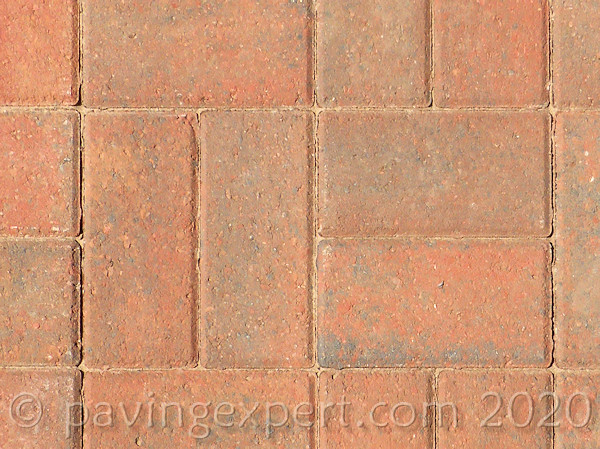
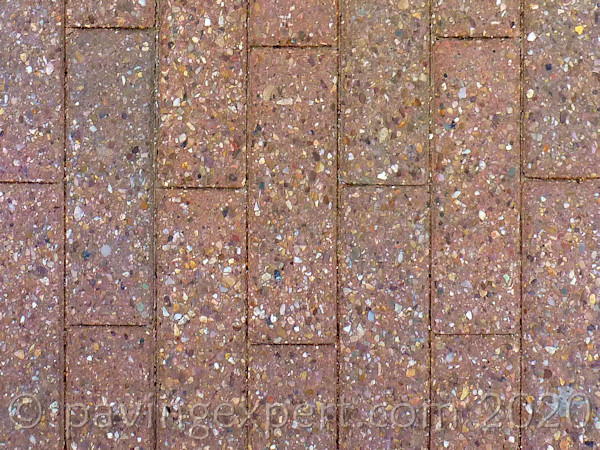 3
3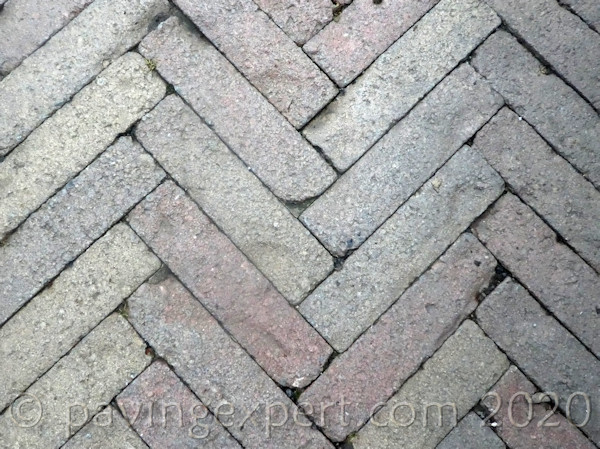
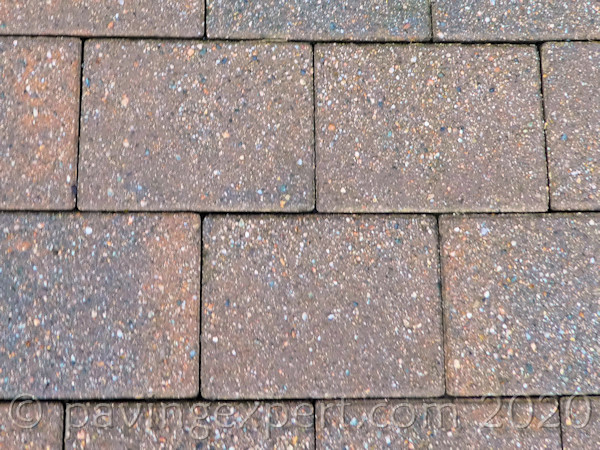
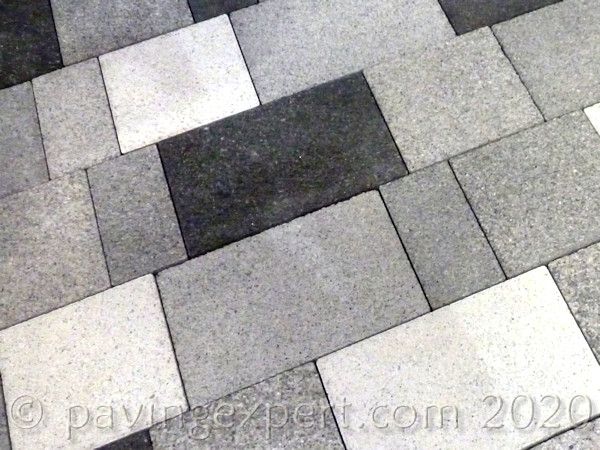
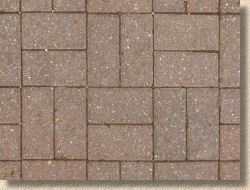

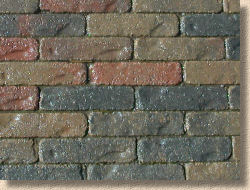
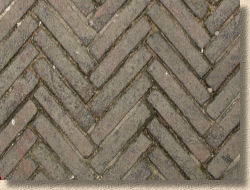
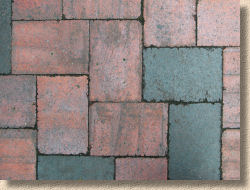
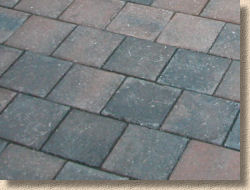
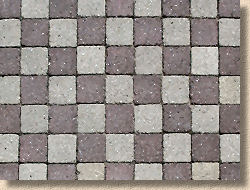
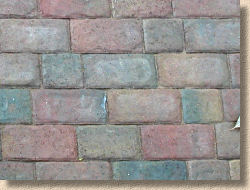
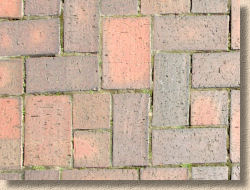
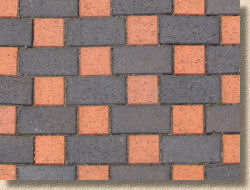
Chamfer: Big or small?
The vast majority of the standard blocks have chamfered edges, more correctly known as 'arrisses'. This detail isn't created solely to emphasise the jointing or individuality of the bricks - there's a sound engineering principle involved.
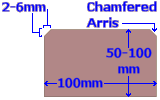
A solid 90° arris is actually a weak point within the block as a whole. If two adjacent blocks are compressed together with the load centred on the interface between the two, then the force is borne by that upper arris. This pressure exerted within the blocks is no longer a wholly compressive force; part of the force becomes tensile, and it is well known that bricks and blocks, fired clay, stone and concrete are superb materials in compression, but are much weaker in tension.

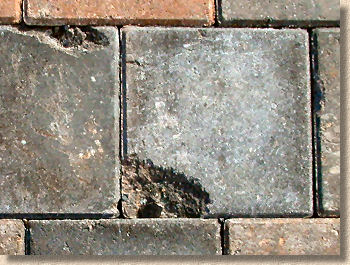
The result is that the upper arris of the blocks is cracked, or, as we call it in the trade "spalled", and the appearance of the block is ruined.
The additions of a small chamfer, however, eliminates this problem more or less completely, which is why chamfered arrisses are a common detail on blocks and brick pavers, on small element paving and on certain other stone/concrete/fired-clay construction materials.
However, all this clever engineering theory doesn't mean very much to the average pedestrian or motorist, unless they are battling against the crud and detritus that accumulates in the chamfered joints, or they are trying to push a fully-laden shopping trolley across a block pavement. Some of the manufacturers have identified this problem and manufacture blocks with minimal chamfers or no chamfer at all.
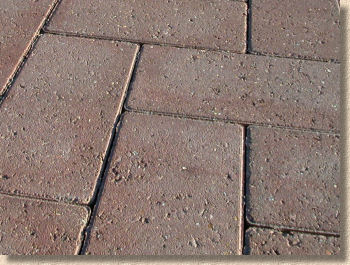
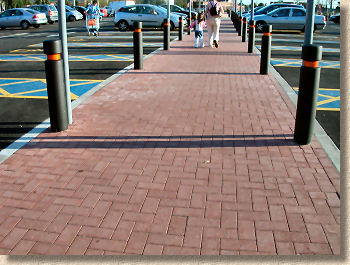
The use of these blocks is usually restricted to those areas that are unlikely to experience heavy loads or vehicular traffic and therefore avoid the conditions that lead to spalling of the block surface. They are a popular choice for supermarkets and retail parks where wayward shopping trolleys, hard enough to steer at the best of times, can be almost impossible to direct on modular paving with 'normal' chamfered joints. Smaller chamfers offer a happy medium: not so much that they make trolley control awkward, but enough to minimise the risk of spalling.
Olde Worlde - Moulded
Standard block and brick pavers are not suitable for all paving projects. The public perception of standard pavers is that they are 'modern', and, as such, aren't really the sort of paving that would be used on older or 'character' properties, or for paving schemes in historic towns. The designers appreciate the manifold benefits of flexible block paving, but the blocks themselves just don't suit the environment.
And so, the olde-worlde looking "Character Block" was developed. By using a mould that gave a dimpled or indented surface to the blocks, these early pioneers genuinely thought they could produce a concrete block that looked like a natural stone sett. While some may have passed as such to a blind man on a galloping horse, they often left something to be desired. Not to beat about the bush, they were bloody awful!
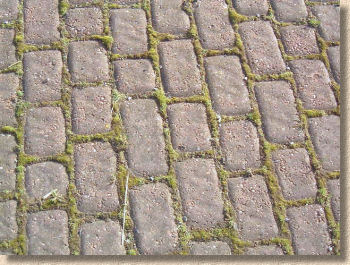
Thankfully, they did get better and nowadays there's a good and fairly tasteful selection ranging from delicate 190x50mm plan thin bricks up to chunky no-nonsense sett-alikes.
Bear in mind when considering these blocks, the more rugged the upper face, the rougher will be the ride when trafficking them, and the really knobbly specimens are not always the best choice for sites where childrens' bikes or wheelchairs might be used.
Other moulded options created blocks with a more stylish look; rounded corners and a slightly domed surface. One of the biggest selling of the early moulded blocks was Classico, manufactured by Marley back then but sold off to Tarmac Toppave in the early part of the 21st century and now owned and produced by Brett. BDC, a company which went on to be swallowed up by RMC which in turn was absorbed into the global Cemex empire had Ionica, which was uncannily similar to the still-in-production Classico.
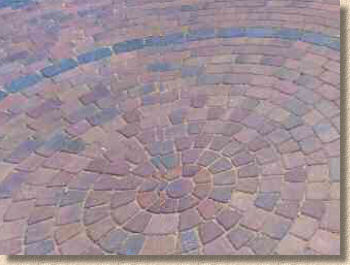
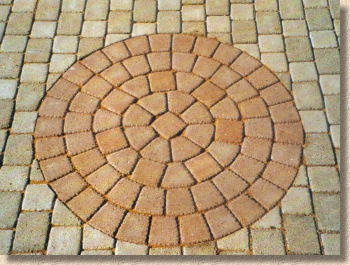
And finally in this all-too brief section, we shouldn't overlook moulded clay pavers, those with some pattern or decoration pressed into the upper face. There used to be dozens of different types but as the market for clay pavers has shrunk, partly due to a change in taste but also because of the sheer bleeding incompetence of some of the clay paver manufacturers, we have a much reduced selection, but if you want something different, they really ought to be considered.
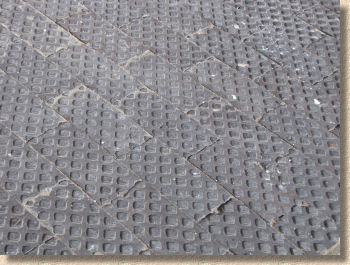
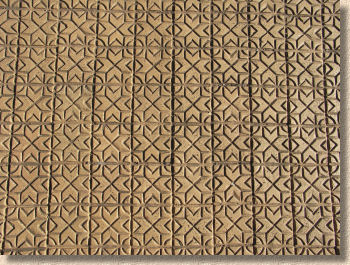
Tumbled - Distressed
Eventually, the manufacturers realised that rather than trying to create convincing replicas of the traditional setts, they could capture the spirit of those setts with a simple product that shared their most essential characteristics - edges softened by time and traffic; soft, organic, muted colours; and a variety of plan sizes.
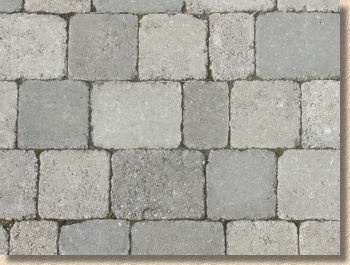
To further enhance the non-uniform appearance of these new products, and give them an air of having lived a bit, they could be deliberately maltreated by having the corners bashed off, and the odd spot of spalling here and there, just as hand-tooled setts would have.
And so, it came to pass that a 'distressed' block paver was created. There's a possibly apocryphal tale of a particular paving manufacturer watching an abandoned house brick being tumbled back and forth by the action of waves on a beach, which allegedly inspired the idea of using machinery to replicate the process and create the instantly time-worn look of many otherwise modern pavers.
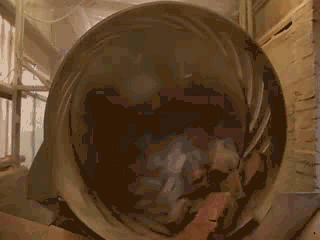
The process involves manufacturing blocks in exactly the same way as standard blocks, by pressing a specifically designed concrete containing earthy-toned dyes into moulds, following which they are allowed to cure as 'perfect' blocks. Then, once the pavers have achieved sufficient strength, they are 'tumbled'. This usually involves putting the cured blocks into the equivalent of a huge concrete mixer and churning them round and round so that they bash against the sides, and each other, taking off all the neat, manufactured arrisses, edges and corners to finally emerge battered, bruised and looking slightly worse for wear.
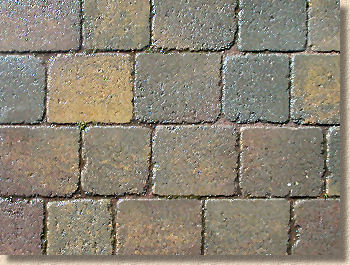
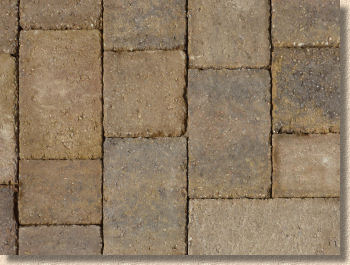
One of the most popular tumbled blocks, throughout the world, is sold under the brand name "Tegula™®" (from the Latin for a tile). It is licensed, usually, to one manufacturer per country, but because of the complexity of relationship between Britain, Northern Ireland and The Republic of Ireland, we often see two versions in mainland Britain: the British version manufactured by Marshalls and the Irish version, manufactured in Northern Ireland, by Tobermore.
But despite what you might reasonably assume, neither the colours nor the plan sizes of the two formats are compatible. The Tegula licence is for a tumbled block, but the choice of size and colour is left to the licensee manufacturers.
And to further complicate matters in Britain, Marshalls make a version of Tegula specifically for the driveway and patio market, which is sold under the name "Drivesett Tegula". This one is compatible with normal Tegula, but is of a shallower depth (50mm rather than the 60 or 80mm formats used for the non-Drivesett version)
Naturally, the other manufacturers want to be able to offer a similar tumbled or distressed product, and almost every major manufacturer does so. However, not all are tumbled; some are distressed in other ways, such as being lightly assaulted by a spherical hammer ( Schindler Process ). This latter process can often leave a distinctive pattern of marks and/or scratches on the surface of the paver, although these will normally weather away in a few weeks once outside in the open.
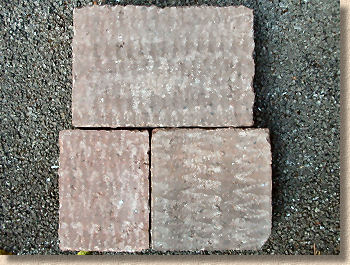
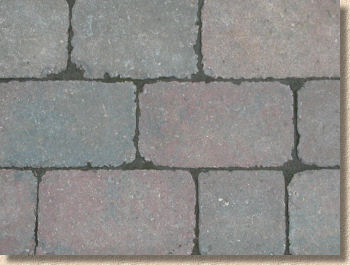

Once they've been laid, and the dust and detritus from the tumbling process has been washed away by the rain, the finished effect can be stunning. They actually do look 'old', as though they have been there for years. They're not all cheesy attempts to mimic natural stone setts, but they have a character of their own that is reminiscent of those rapidly-disappearing sett-paved streets.
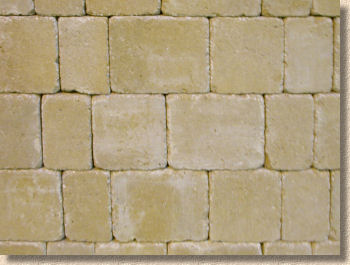
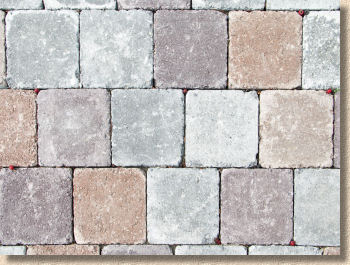
With the tumbled/distressed blocks, there are three basic methods of creating the overall colour-effect.
- Use a single, homogenous colour for every block (above left)
- Use a mix of blocks each one being a single colour from a range of 3-5 colours (above right)
- Use blocks were the colours are mixed within each block (previous images)
Naturally, the extra processing and extended production time bumps up the price of these products compared to the standard pavers, but it's a premium many end users are willing to pay if it gives them all the benefits of a modern, modular, low-maintenance and easily installed paving plus the look and period charm of a fabled bygone age that never actually existed.
It's not just concrete blocks that can be tumbled or distressed: the same techniques can be applied to clay pavers.
Sadly, the last popular format of tumbled clay paver manufactured in Britain (Ireland has no tradition of clay paver manufacturing), shown opposite, has been withdrawn and now we have to rely on imports, which are all well and good, but they're not what might be considered "native" colours.
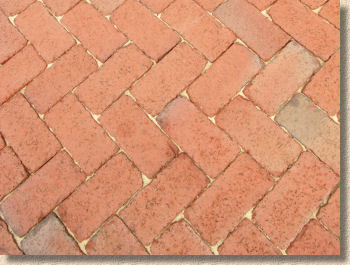
Decorative Textured and Patterned Pavers
The manufacturers allow us to choose from a kaleidoscope of colour , we can choose blocks that would seem to come from a future or a previous age , and we can choose almost any shape imaginable, so what else can be tweaked in the eternal search for something different? Texture and pattern!
The technology exists to imprint patterns into the surface of pavers, or to treat the surface to create an original or interesting alternative texture to the usual pressed-mould concrete or dragwire clay.
Blocks in this group are textured and patterned pavers, but we exclude pavers which are tactile indicators. A decade ago, there were far more, but as the economy has struggled, the smorgasbord of pavers on offer has been rationalised, so we now see fewer than we once did.
Textured Pavers:
Are often perceived to offer better traction, although this is not always the case. Some use the texture to show off a particular aggregate.
There are different types of textured pavers:
- Exposed Aggregate - an upper surface of attractive aggregate is exposed and enhanced by removing a small part of the 'paste' of fine aggregate and cement which holds the concrete together
- Coarse Texturing - shot blasting or bush hammering is used to roughen the surface
- Polishing - Honing - Grinding - the upper surface is polished to reveal the internal structure of the paver
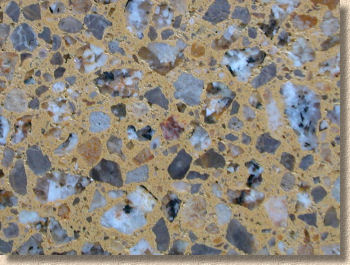
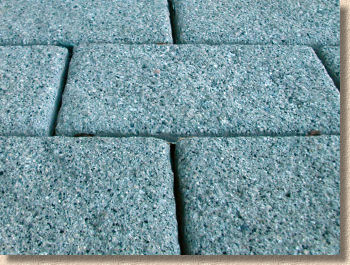
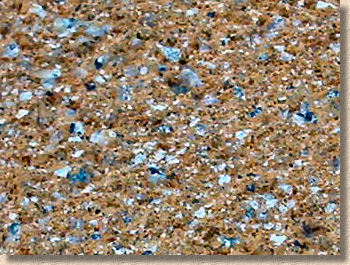
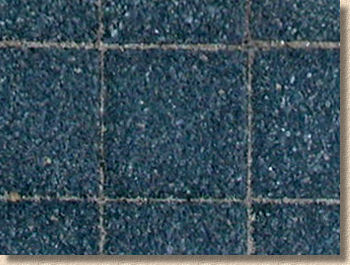
Patterned Pavers are those which have a distinctive pattern stamped or moulded or embossed into their upper surface.
There is considerable overlap between moulded and patterned pavers as the pattern is very often created using a mould.
Patterned moulding is common to both clay and concrete products, and may range from the simple formation of a false v-joint to give the appearance of smaller units, to complex decorative stylings. Some examples are shown below...
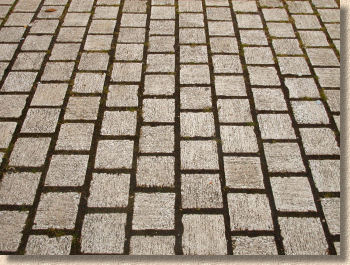
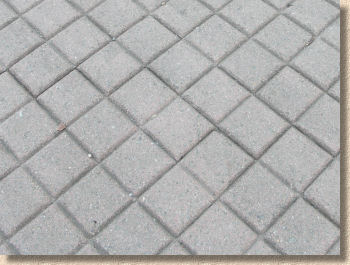
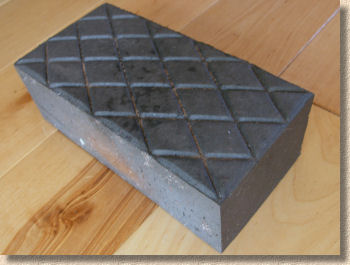
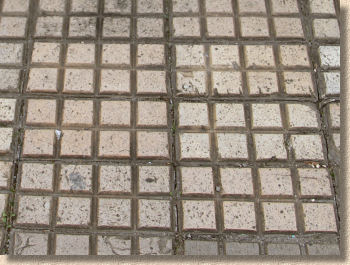
Care is needed in choosing a textured or patterned paver. Unless the planned pavement is going to be rigorously maintained or will be self-cleansing, much of the intricate detail can rapidly disappear beneath a crust of moss and/or detritus. What looks like a wonderful idea on the designer's drawing board can have a relatively short useful lifespan out there in the real world. Recessed patterning fills up with dust and detritus, coarse textures are more attractive to vegetation than the standard, smoother pavers, and exposed aggregates are not always appreciated for what they are.
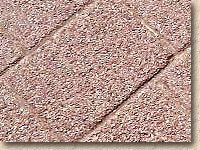
There's no doubt that these decorative pavers have their uses, but their market is limited and in many cases, more attractive paving schemes can be designed using simpler, cheaper pavers.
Special Applications
This category includes blocks that are normally used for non-residential paving projects, although there's no reason why they couldn't be used for such projects if so desired.
These 'Special Apps' can be grouped as follows....
- - Permeable paving systems
- - Machine-laid paving systems
- - Colour-top blocks used to create yellow lines or reflective traffic markings
- - Heavy-duty exceptional load bearing systems
- - Sealed systems for industrial/chemical applications
Permeable Paving
Permeable paving is used for both residential and commercial projects. When the comedy legislation covering front garden driveways was laughed through the British parliament in 2008, there was a belief from some in the industry that this would give a massive boost to the use of permeable paving (referred to as CBPP - Concrete Block Permeable Paving - in technical texts) but that was a little optimistic, to put it mildly.
Currently, the main use for permeable paving is commercial car parks but hopefully this will change as the understanding of the systems involved improves and the changes in climate force a re-think of what we do with surface water.
Most CBPP works by having wider-than-normal joints, but other than oversized spacer lugs, the blocks themselves are identical in structure, colour, texture and everything else to the non-permeable versions which may be standard, distressed, textured or whatever as described above.
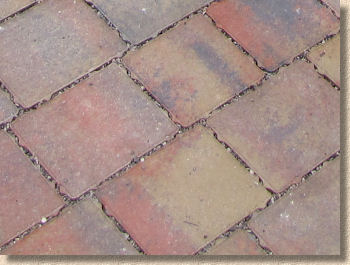
Machine Lay Paving
Machine-lay paving , like the permeable stuff discussed above, is more-or-less identical to what we might call "normal" paving once laid. The key difference, as the name indicates, is that the blocks are largely laid by a machine of some description, rather than by hand.
While there are ranges of blocks that have been specially developed for machine lay (ML) and are not really intended for manual installation, many of the more popular options are simply 'normal' blocks that have been pre-arranged into 'clusters' that allows them to be lifted as a panel and plonked down onto a prepared bed, covering a large area in very little time.
In fact, it's virtually impossible to tell whether an area of paving has or hasn't been laid by machine once it's down and trafficked-in.
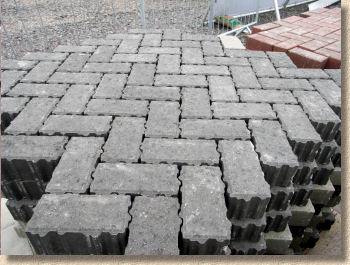
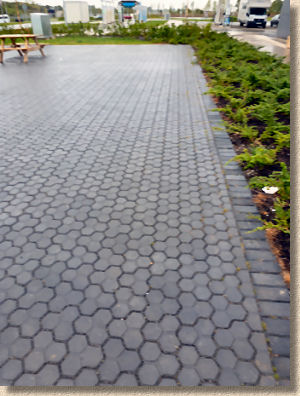
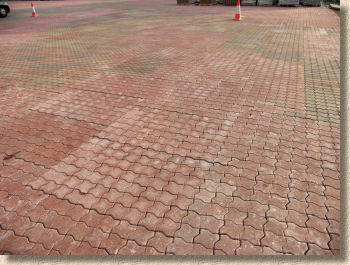
With some machine lay paving projects, it's practically impossible to tell that the blocks have been laid as clusters by a machine (left), whereas on other jobs, you'd have to be blind not to notice (right)
Colour-tops and Reflectors
Colour-tops, reflector blocks and marker blocks form a category where the paving has a function other than to solely provide a suitable surface. Very often, these items are 'standard' pavers that have been coated with a special topping to give them an exceptionally hard-wearing or even a light reflecting surface.
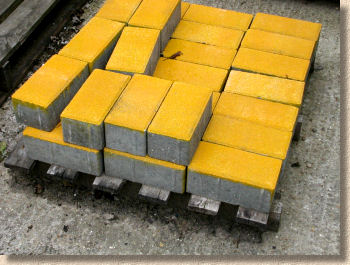
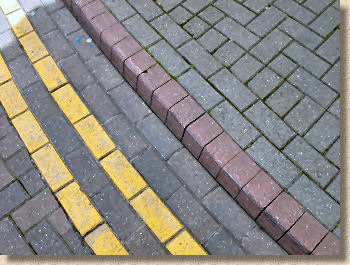
These 'elemental' colour providers offer several advantages: no need to bring in expensive thermoplastic line marking kit when you have a bit of remedial work following a pipe or cable repair, for example, and it has to be admitted that the double yellow line looks much neater and more attractive within a block pavement than the splodged over-painted lines used on some projects.
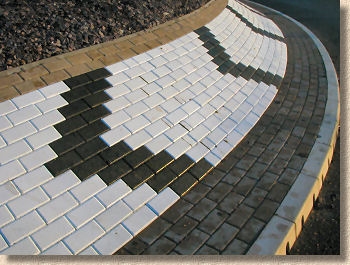
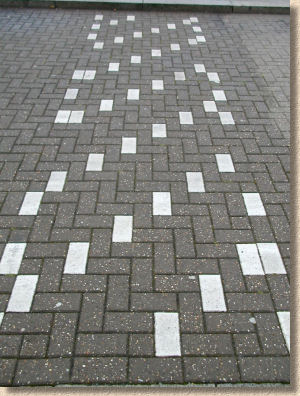
The black and white reflective blocks are superb for creating unmissable chevron roundabouts, but they are also eminently useful for de-marking bays in car parks where lighting at night might not be particularly effective.
Heavy Duty Paving:
This category of special applications is fairly self-explanatory. It's simply block paving developed for use in areas subjected to exceptional loads, which is usually taken to be ports, freight yards, airports, waste transfer stations, industrial yards and the like.
As you might reasonably expect, the more decorative finishes and fancy colours are largely eschewed in favour of performance, and in most cases, that performance is provided via blocks that are 100 or 120mm thick.
Many heavy duty pavers are rectangular, but in Europe, and increasingly in Britain and Ireland, shaped pavers, which provide greater horizontal interlock, are being used.
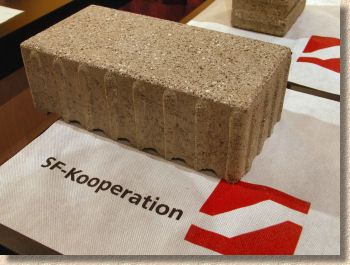
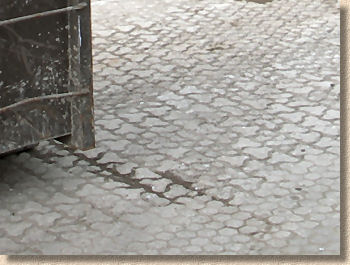
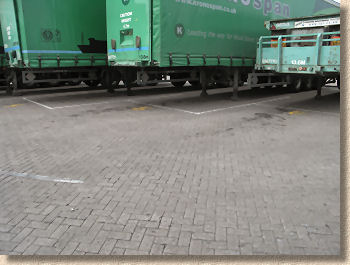
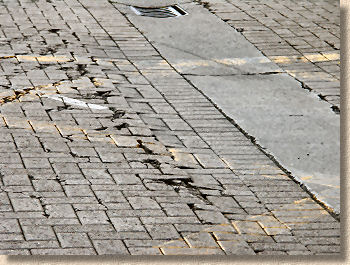
Sealed Surface Paving
This category of block paving may be thought of as the complete opposite of permeable paving, in that it goes to extreme lengths to *prevent* liquids getting into the pavement structure.
This is achieved by sealing the top 10-20mm or so of the joints with a polysulphide sealant, which is chosen because of its oil-resistant properties, which make this paving system particularly attractive to filling stations and fuelling areas in freight yards, as the joint is flexible and so can accomodate minor movement without 'cracking' and so breaching the pavement integrity.
